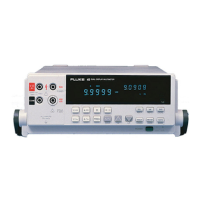45
Service Manual
2-18
provides 2 mA of current through A1VR1. Resistor network A1Z3 divides the 6.3 V
down to 1.1 V.
BUFFER
A1Z3
INTEGRATOR
INTREGRATE
REFERENCE
INTEGRATE
INPUT
INPUT
–REFERENCE
(+ INPUT)
REFERENCE
+ REFERENCE
(– INPUT)
S77
A1C16
+
_
_
+
+
_
A/D
COMPARATOR
+
_
COUNTER
qb08f.eps
Figure 2-8. A/D Converter Simplified Schematic
2-33. Serial Communication (Guard Crossing)
The Microprocessor communicates with the Analog Measurement Processor using this
isolated two-wire, full-duplex asynchronous interface circuit.
When the Microprocessor is transmitting to the Analog Measurement Processor, the
transmit data bits appear at A1U6-11, which drives the combination of AQ19, A1R33
and A1U3-1. The optocoupler A1U3 then optically transfers this information to its
output circuit, comprised of A1U3-7, A1R30, A1R28 and A1R27. The transmitted data
is then presented to A1TP4 and A1U1-40.
When the Analog Measurement Processor is transmitting data back to the
Microprocessor, the data bits appear at A1U1-39, which drives the input of a Darlington
driver A1U2-1. The Darlington driver output then drives A1R29 and A1U4-1 to transfer
the information to the output of the optocoupler at A1U4-7. Resistors A1R32 and A1R34
complete the optocoupler output circuit. Data is then routed to A1TP7 and A1U6-10 on
the Microprocessor.
2-34. Digital Kernel
The Digital Kernel is composed of six functional circuit blocks: the RS-232 interface,
the Microprocessor, the EEROM (Electrically Erasable Read Only Memory), the RAM
(Random Access Memory), the ROM (Read Only Memory), and the IEEE-488 Option
Connections. These blocks are described in the following paragraphs.

